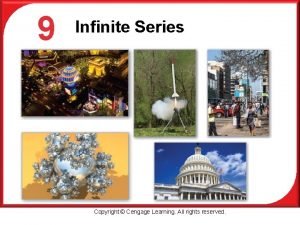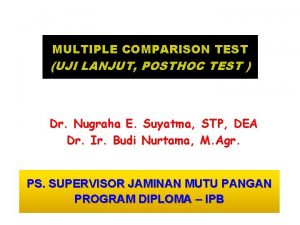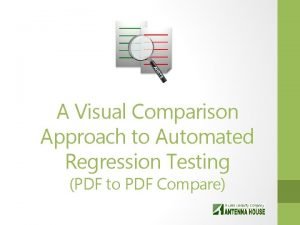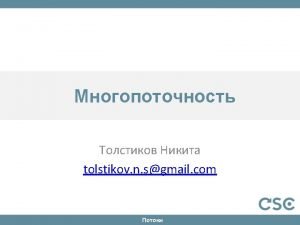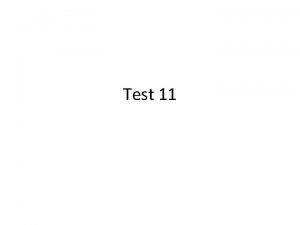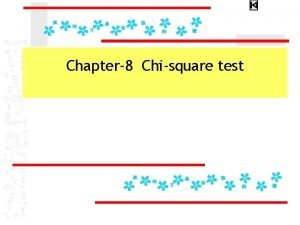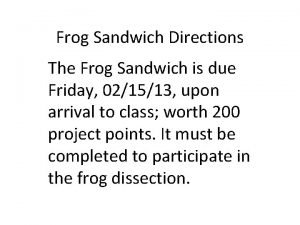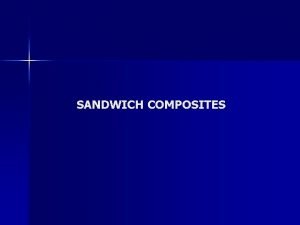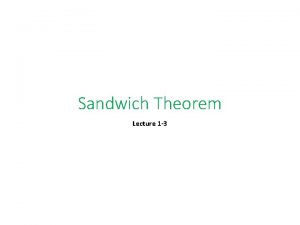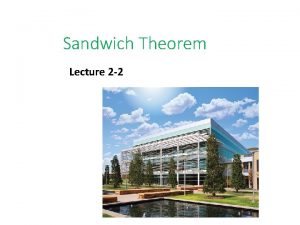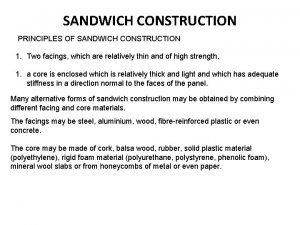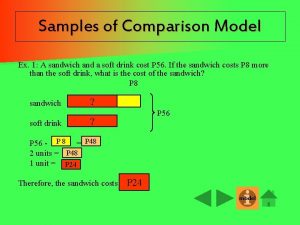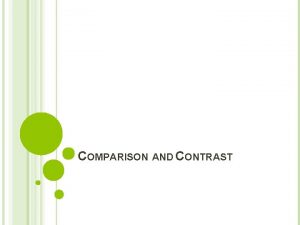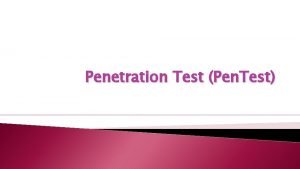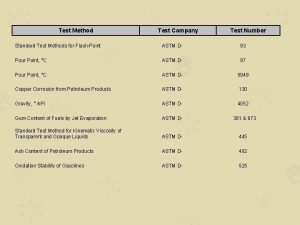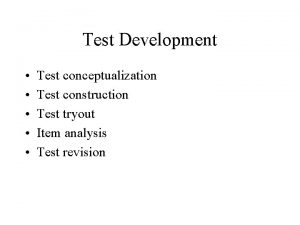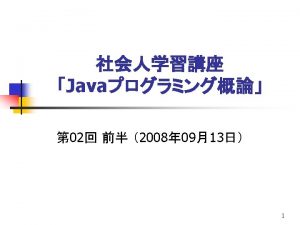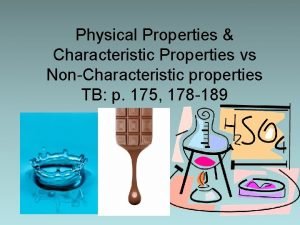A comparison of Some Properties of Sandwich Test





















- Slides: 21

A comparison of Some Properties of Sandwich Test Tokens with Various Core Materials (Tim)

Aim • Previously have destructively measured (3 -pt bend & FWT) sandwich test tokens (before & after irradiation) – K 13 D 2 U/RS-3 80 gsm/ 29%RC (0/90/0) – UCF-126 -3/8 -2. 0 honeycomb – Hysol EA 9396 / ACG VTA 260 (film) • Different failure modes – Hysol: failure of glue interfaces at low load – VTA 260: failure of facesheets but at much higher loads • This work – Begin to repeat previous tests with more samples, different materials, different glues / application techniques – Limit measurements to 3 -pt bend as force-extension curve gives compliance, failure load and information on failure mechanisms. 28/08/2012 Properties of Sandwich Test Tokens 2

Previous Work • 3 -pt bending – All sample sealed in vacbag material to contain debris – Measure load vs extension • Break at maximum load • Slope gives approximate bending compliance • Post maximum behaviour reveals failure mechanism 28/08/2012 Properties of Sandwich Test Tokens 3

Results Sample Slope N/mm 50 N 100 N 150 N 200 N 300 N Hysol / non-irrad 262 Pass 114. 1 Hysol / irrad 269 Pass 79. 4 VTA 260 / non-irrad 396 Pass 297 VTA 260 / irrad 379 Pass Pass 400 N 322 140 VTA 260 Irrad 320 VTA 260 / Non irrad Hysol / Non-irrad 100 Load (N) 240 Load (N) Hysol / Irrad 120 160 80 60 40 80 20 0 0 0. 25 28/08/2012 0. 5 0. 75 1 1. 25 Extension (mm) 1. 5 1. 75 2 0 0 0. 2 Properties of Sandwich Test Tokens 0. 4 0. 6 0. 8 1 Extension (mm) 1. 2 1. 4 4 1. 6

Failure Mechanisms • Peak followed by monotonic fall 300 VTA 260 Non-irrad – Characteristic of single break in top facesheet under roller – Glue joints intact 250 Hysol / Non-irrad Load (N) 200 150 • Peak followed by ‘staircase’ 100 50 0 0 0. 2 28/08/2012 0. 4 0. 6 0. 8 1 Extension (mm) 1. 2 1. 4 1. 6 – Characteristic of progressive failure of glue joints – Face sheets & honeycomb intact Properties of Sandwich Test Tokens 5

• Geometry New Samples – 150 mm x 40 mm (width determined by corrugations) • Common items – K 13 D 2 U/RS-3 (80 gsm, 29%RC) 0/90/0 (& 90/0/90) – Hysol EA 9396 glue bath (0. 5 mm deep) – All samples cured in 2 steps at 66 C • Core Materials ‘ 0’ – UCF-136 -3/8 -2. 0 Carbon fibre honeycomb • Cell size ~ 9. 6 mm – Schutz Cormaster N 636 (‘Korex replacement’) • Cell size ~ 4. 8 mm – QMUL Corrugation • Test • 13 mm pk-pk / 100 gsm plain-weave (+/- 45 deg) – 3 -point bending – Increased maximum load • Eg: 100 N, 150 N, 200 N. . . – Record failure load and slope at between 80 and 120 N (if possible) else 60 N to end of linear region 28/08/2012 Properties of Sandwich Test Tokens 6

Corrugated CFRP Core? • Original Motivation: Ultracor CFRP honeycomb is expensive – what does it do for us? • Thermal Conductance across stave: – Sensor + Facing ~ 0. 3 mm × 200 W/m. K + 0. 21 mm × 140 => 90. Close-outs Boron 0. 6% Nitride 1. 6% Teflon Film 0. 7% Consumabl es Hysol 9396 0. 5% 1. 8% Tube 10. 6% Foam 11. 9% Honeycom b 39. 0% Pre-preg 32. 7% – Honeycomb: 2 mm × 3 W/m. K => 6 … i. e. 7% improvement BUT problem coupling to it! Honeycomb is ignored in UK thermal FEA) • Alternative: 45 o weave CFRP pre-preg: cured between precision plates machined to produce a corrugated CFRP. 28/08/2012 Properties of Sandwich Test Tokens 7

Plank #5 • Corrugation with dot pattern of Hysol 9396 • BN-loaded Hysol for POCOfoam 20/09/2011 8

Issues (potential) with Corrugations • Mechanical Structure very similar to cardboard box / packaging! – Stiff along length (tilted walls) and width (trapezoidal structure). – Relatively easy to fold width-wise (ultimately facing buckles / breaks). • Natural to consider combination with 90 -0 -90 facings (i. e rotated wrt usual) - Lower facing Z modulus compensated by corrugations. Hence: – Improved X thermal conductance: Temperature Headroom 21. 5 => 23. 2 degrees (more so for DCDC etc? ). More uniform T vs X. – Co-cured facing easier to assemble? (curl along length? ) – Double up 90 layers: mechanically safer for (UK) cantilever mount? • Geometry & Mass Issues – (very) slight ripple in across X ? – slightly more massive (needs optimising). 28/08/2012 Properties of Sandwich Test Tokens 9

0/90/0 Beams 220 200 n 636_1_100 200 180 n 636_1_200 180 160 N 636_2_200 160 140 120 Load (N) 220 100 80 80 60 60 40 40 20 20 0 CF_100 0 0 0. 25 0. 75 1 1. 25 Extension (mm) 0/90/0 Core CF Mass Beams Mass CF N 636 3. 949 Corrug N 626#2 28/08/2012 1. 052 0. 908 1. 205 0. 908 nonglue parts 5. 001 4. 857 5. 154 4. 857 1. 5 1. 75 2 Final Mass Glue /m 2 5. 318 6. 335 5. 856 5. 948 0. 316 1. 478 0. 703 1. 091 33 154 73 114 0 0. 25 0. 75 1 1. 25 Extension (mm) % Thk % glue (core (mm) + glue) 6% 26% 5. 45 23% 38% 5. 65 12% 33% 4. 88 18% 34% 5. 63 Properties of Sandwich Test Tokens 1. 5 1. 75 2 Core (hcf/h)^ D Failure (mm) 3 (N/mm) (N) 5. 08 5. 28 4. 51 5. 26 1. 00 0. 89 1. 43 0. 90 268 279 247 273 100 199 122 167 10

90/0/90 Beams 200 175 Load (N) 150 N 636 125 100 75 50 25 0 0 90/0/90 Core CF Mass Beams Mass CF N 636 Corrug 3. 82 28/08/2012 1. 0250 0. 9650 1. 2850 0. 25 non. Assemb glue led compon Mass ents 4. 8450 5. 3403 4. 7850 5. 9148 5. 1050 5. 6953 0. 5 0. 75 1 1. 25 Extension (mm) 1. 5 % Glue Thk glue/m 2 % glue (core+gl Mass (mm) ue) 0. 4953 1. 1298 0. 5903 52 118 61 9% 10% 28% 35% 33% Properties of Sandwich Test Tokens 5. 55 5. 68 4. 86 1. 75 2 Core (hcf/h)^ D Failure (mm) 3 (N/mm) (N) 5. 18 5. 31 4. 49 1. 00 0. 93 1. 54 129 234 184 75 150 99 11

Conclusions (so far) • CF Honeycomb beams – – Slope ≈ 270 N/mm Failure load ≈ 100 N Very similar to 2011 beams Failure is ALWAYS at glue interface between honeycomb and face sheet • Corrugated Beams – Slope ≈ 250 N/mm so very similar to CF (and N 636) beams DESPITE being 0. 5 mm thinner! – Failure at about 122 N – buckling of facesheet in un-supported regions • N 636 Beams – Highest mass (x 2 range in glue gsm), failure loads (160 -200 N) & bending stiffness – 0/90/0 vs 90/0/90 looks strage! 28/08/2012 Properties of Sandwich Test Tokens 12

A note on Honeycomb Glue Mass 28/08/2012 Properties of Sandwich Test Tokens 13

Transverse Bending Stiffness of 120 mm beams • Samples – 0/90/0 + corrugation (90) – 0/90/0 + N 636 – 90/0/90 + N 636 ‘ 0’ • Use 1. 6 mm aluminium shims to spread loads & prevent premature face sheet failure • Adjust bending length to 93 mm to optimise for corrugation geometry 28/08/2012 Properties of Sandwich Test Tokens 14

Transverse Bending Stiffness of 120 mm beams (L ≈ 93 mm) Corrugation N 636 60 105 106 107 40 Load (N) 114 20 0 0 0. 25 Transverse Beams 0. 5 0. 75 1 1. 25 Extension (mm) CF Mass Core Mass N 636 (90/0/90) N 636 (0/90/0) 3. 056 Corrug (Trans) 0. 772 1. 028 28/08/2012 nonglue parts 3. 828 4. 084 1. 5 1. 75 2 280 260 240 220 200 180 160 140 120 100 80 60 40 20 0 115 0 0. 25 0. 75 1 1. 25 Extension (mm) 1. 5 1. 75 2 Assy Glue Mass Glue /m 2 % % (core Thk Core (hcf/h) D Failure glue +glue) (mm) ^3 (N/mm) (N) 4. 57 5. 15 4. 53 77 138 46 16% 26% 10% 0. 742 1. 322 0. 446 33% 41% 33% Properties of Sandwich Test Tokens 5. 68 4. 86 5. 31 4. 49 0. 93 1. 54 161 212 37 182 243 40 15

Improving the Longitudinal Bending Properties of Hysol-Glued Beams With CF Honeycomb • Hysol-glued beams with UCF-126 -3/8 -2. 0 honeycomb fail at: – 80 N, 114 N (2011 non-irradiated samples) – 75 N, 100 N (2012 samples) • Glue Application – – Dip honeycomb in trough of depth ~ 0. 5 mm Agitate a bit Leave for a couple of minutes Hysol-glued UCF honeycomb cores always have low mass & failure load • How much glue is needed to raise failure load? • Methods – Stencil – Uniform thin layer 28/08/2012 Properties of Sandwich Test Tokens 16

Stenciling • Laser-cut 0. 5 mm thick perspex stencil – Need to load adhesive with hollow micro-spheres to increase viscosity to inhibit bleed under stencil (and reduce density) 0/90/0 150 x 40 mm CF + Stencil Non% As built Glue glue/ % Thk glue (core+glu Mass m 2 glue (mm) Parts e) 3. 879 1. 025 4. 904 6. 053 1. 149 96 19% 36% 5. 48 CF Core Mass 28/08/2012 Properties of Sandwich Test Tokens Core D Failure (hcf/h)^3 (mm) (N/mm) (N) 5. 11 1. 00 370 218 17

Stencil Beams 250 225 200 127 175 Load (N) 150 125 100 75 50 25 0 0 0. 1 0. 2 0. 3 0. 4 0. 5 0. 6 0. 7 0. 8 0. 9 1 1. 2 1. 3 1. 4 1. 5 1. 6 1. 7 1. 8 1. 9 Extension (mm) 2 • Break at 218 N due to failure of the (top) face sheet under top roller 28/08/2012 Properties of Sandwich Test Tokens 18

Uniform Glue Layer • Application – Spread thin(-ish) glue layer over whole face sheet – Locate honeycomb – Cure Non% CF Core As built Glue glue/ % Thk Core (hcf/h)^ D Failure glue (core+ Mass m 2 glue (mm) 3 (N/mm) (N) Parts glue) 3. 879 1. 025 4. 904 6. 01 1. 106 92 18% 35% 5. 48 5. 11 1. 00 284 153 0/90/0 150 x 40 mm Hysol film 200 134 175 135 150 136 137 Load (N) 125 138 100 75 50 25 0 0 28/08/2012 0. 4 0. 6 0. 8 1 Extension (mm) 1. 2 Properties of Sandwich Test Tokens 1. 4 1. 6 1. 8 2 19

Properties of CF Honeycomb beams vs glue mass Glue Method Sample Date Glue Mass (g/m 2) Bending Stiffness (N/mm) Failure Load (N) Dip 2011 N/A 262, 269 79, 114 Dip 2012 33 268 100 Stencil 2012 96 370 218 Even Layer 2012 92 284 153 VTA 260 2011 188 379, 396 297, 322 • Notes – VTA 260 mass can be reduced by cutting out honeycomb pattern – Loading Hysol with hollow glass spheres seems to stiffen the adhesive ? 28/08/2012 Properties of Sandwich Test Tokens 20

What Next? • Establish the ‘machine stiffness’ (don’t have a true displacement sensor) to enable the exact load-extension curves to be determined • Cantilever bending of transverse test samples – Short section with ‘full stave’ cross-section (i. e. C-channels, core, Pocofoam etc. . – Clamp at one side using 15 mm x 4 mm block glued into C-channel & load ‘free’ end • Try Amber Composites EF 8020 (100 gsm) glue film • Repeat stencilling trials with different amounts of hollow glass spheres • Investigate if it’s possible to control the amount of glue N 636 honeycombs ‘pick up’ during a simple ‘dip’ • Investigate effects of cure temperature and pressure 28/08/2012 Properties of Sandwich Test Tokens 21
 Compairson test
Compairson test Sliding into a slit sandwitch
Sliding into a slit sandwitch Sometimes you win some sometimes you lose some
Sometimes you win some sometimes you lose some God when you choose to leave mountains unmovable
God when you choose to leave mountains unmovable Countable and uncountable ice cream
Countable and uncountable ice cream Contact and non contact forces
Contact and non contact forces Fire and ice diamante poem
Fire and ice diamante poem Some say the world will end in fire some say in ice
Some say the world will end in fire some say in ice Some trust in horses
Some trust in horses What are chemical properties of matter
What are chemical properties of matter Some properties of glass
Some properties of glass Intensive property and extensive properties
Intensive property and extensive properties Chemical property of matter
Chemical property of matter Compairson test
Compairson test Multiple comparison adalah
Multiple comparison adalah Visual comparison test
Visual comparison test Direct comparison test
Direct comparison test Some test keyword 09
Some test keyword 09 Missed some points on the visual field test for dvla'
Missed some points on the visual field test for dvla' Some test keyword 09
Some test keyword 09 The mvc will monitor a new driver’s habits for how long?
The mvc will monitor a new driver’s habits for how long? Type of chi-square test
Type of chi-square test













